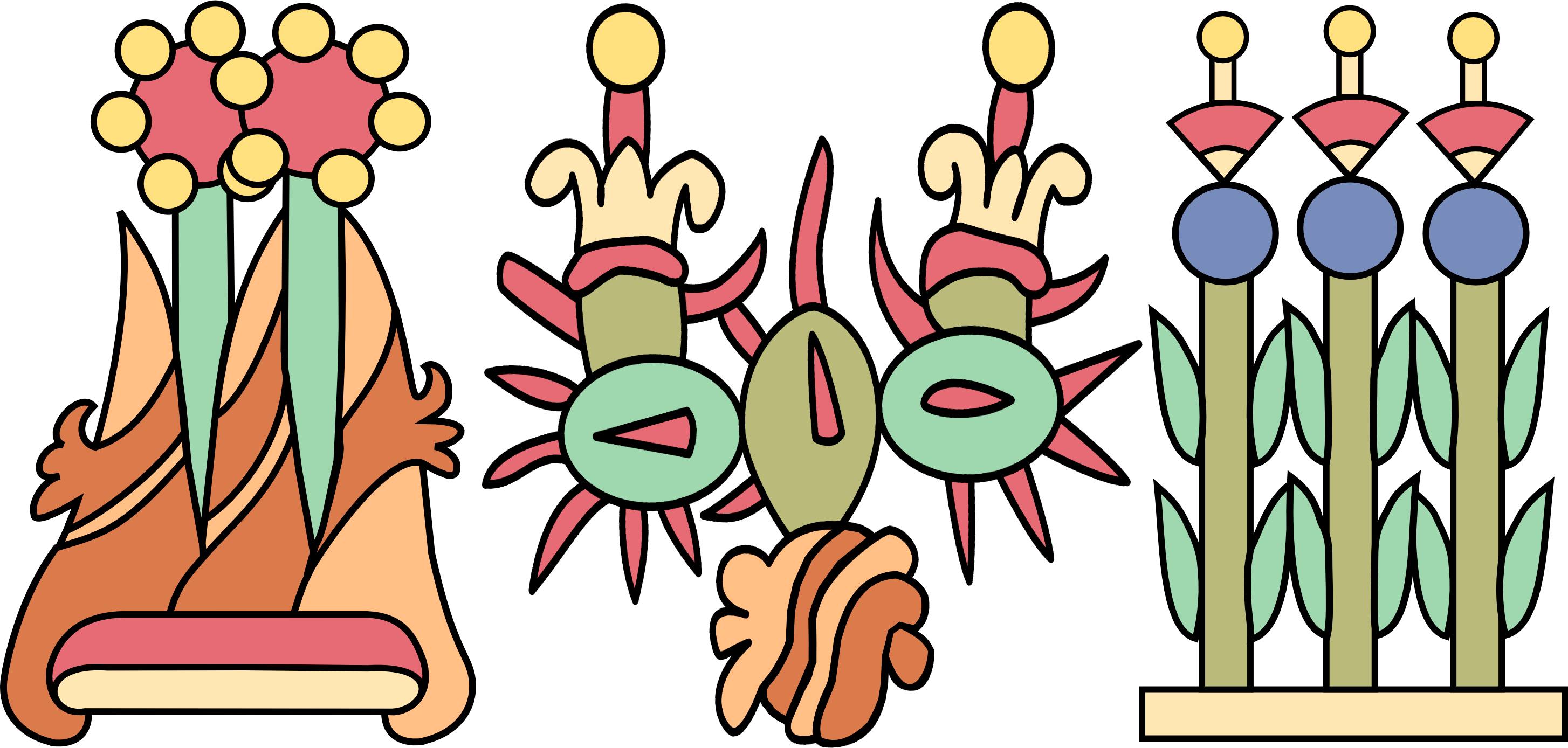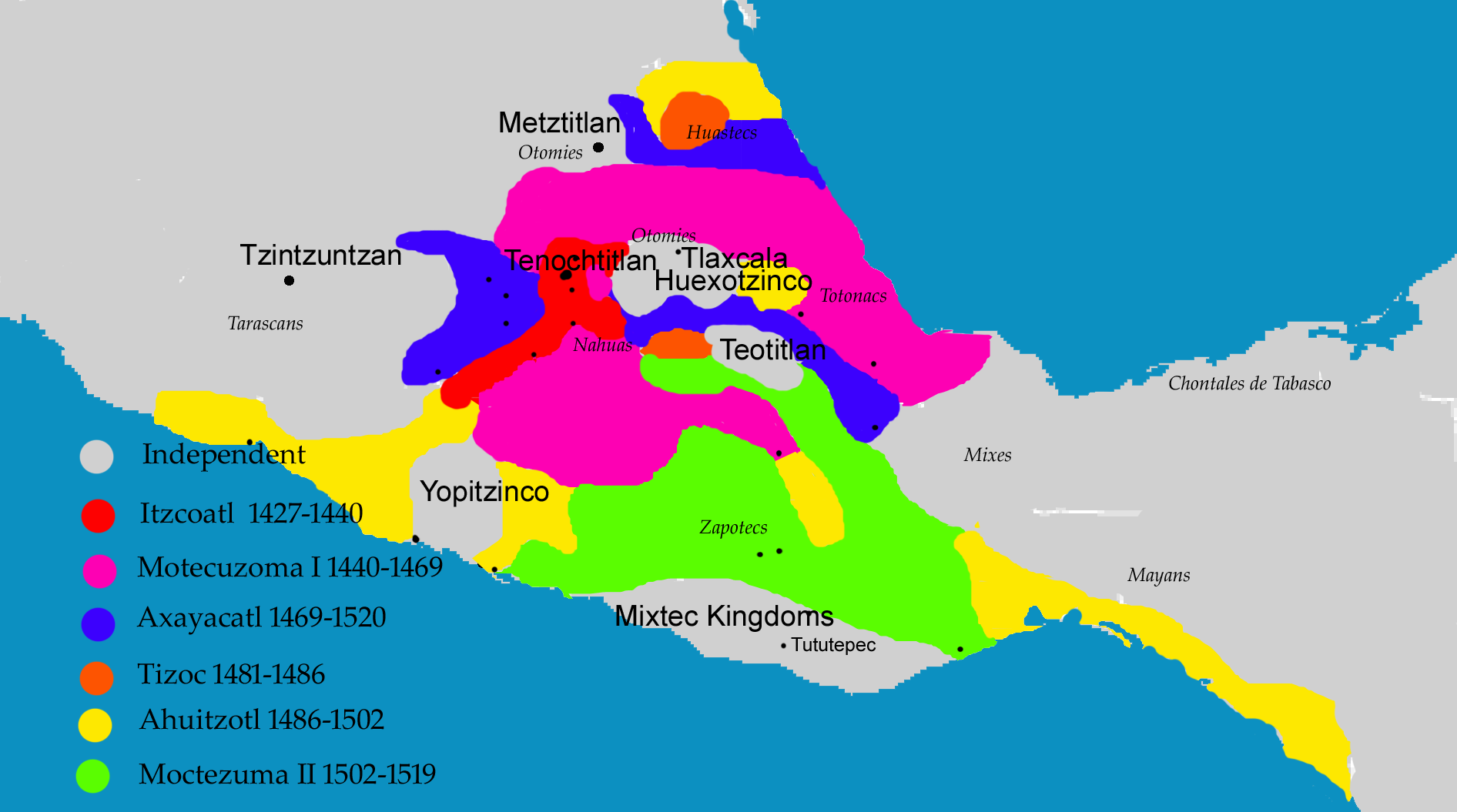|
Moquihuix
Moquihuix (or Moquihuixtli) (died 1473) was the fourth ''tlatoani'' (ruler) of Tlatelolco. He died in 1473 in the Battle of Tlatelolco, a military conflict fought between Tlatelolco and Tenochtitlan. Moquihuix was married to Chalchiuhnenetzin, younger sister of the Tenochca ruler Axayacatl, after whom their son Axayaca was named. However, it is said that Moquihuix neglected Chalchiuhnenetzin, preferring the company of other women. A funerary urn that may belong to Moquihuix was found in 1978 at the site of the Templo Mayor of Tenochtitlan, near the Coyolxauhqui Stone The Coyolxāuhqui Stone is a carved, circular Aztec stone, depicting the mythical being Coyolxāuhqui ("Bells-Her-Cheeks"), in a state of dismemberment and decapitation by her brother, the patron deity of the Aztecs, Huitzilopochtli. It was red ....Umberger (2007). Notes References * * * {{S-end 15th-century births 1473 deaths Year of birth unknown Tlatoque of Tlatelolco ... [...More Info...] [...Related Items...] OR: [Wikipedia] [Google] [Baidu] |
Chalchiuhnenetzin
::''This is an article about one queen. Names similar to her are that of deities Chalchiuhtotolin and Chalchiuhtlicue and queen Chalchiuhcozcatzin.'' Chalchiuhnenetzin ("noble jade doll"; ''chal-cheeoo-neh-NEH-tseen'') was an Aztec princess of Tenochtitlan, and a Queen consort of Tlatelolco by marriage to Moquihuix of Tlatelolco. She is foremost known in history for the famous legends about her lovers. Biography Family She was a daughter of prince Tezozomoc and his cousin, princess Atotoztli II. She was the sister of the emperors Axayacatl, Tizoc and Ahuitzotl and the aunt of Moctezuma II and Cuitláhuac. Marriage Chalchiuhnenetzin married Moquihuix (d. 1473), king of Tlatelolco, an ''altepetl'', or city-state. She had a son with him, Axayaca, named after her brother. Moquihuix neglected Chalchiuhnenetzin, preferring the company of other women. Reportedly, he was not attracted to her because she "was quite thin, was not fleshy". He gave the gifts sent to her by ... [...More Info...] [...Related Items...] OR: [Wikipedia] [Google] [Baidu] |
Tlatelolco (altepetl)
Tlatelolco ( nci-IPA, Mēxihco-Tlatelōlco, tɬateˈloːɬko, ) (also called Mexico Tlatelolco) was a pre-Columbian altepetl, or city-state, in the Valley of Mexico. Its inhabitants, known as the ''Tlatelolca'', were part of the Mexica, a Nahuatl-speaking people who arrived in what is now central Mexico in the 13th century. The Mexica settled on an island in Lake Texcoco and founded the ''altepetl'' of Mexico-Tenochtitlan on the southern portion of the island. In 1337, a group of dissident Mexica broke away from the Tenochca leadership in Tenochtitlan and founded Mexico-Tlatelolco on the northern portion of the island. Tenochtitlan was closely tied with its sister city, which was largely dependent on the market of Tlatelolco, the most important site of commerce in the area. History In 1337, thirteen years after the foundation of Tenochtitlan, the Tlatelolca declared themselves independent from the Tenochca and inaugurated their first independent ''tlatoani'' (dynastic ruler). ... [...More Info...] [...Related Items...] OR: [Wikipedia] [Google] [Baidu] |
Axayacatl
Axayacatl (; nci, āxāyacatl ; es, Axayácatl ; meaning "face of water"; –1481) was the sixth of the of Tenochtitlan and Emperor of the Aztec Triple Alliance. Biography Early life and background Axayacatl was a son of the princess Atotoztli II and her cousin, prince Tezozomoc. He was a grandson of the Emperors Moctezuma I and Itzcoatl. He was a descendant of the king Cuauhtototzin. He was a successor of Moctezuma and his brothers were Emperors Tizoc and Ahuitzotl and his sister was the Queen Chalchiuhnenetzin. He was an uncle of the Emperor Cuauhtémoc and father of Emperors Moctezuma II and Cuitláhuac. Rise to power During his youth, his military prowess gained him the favor influential figures such as Nezahualcoyotl and Tlacaelel I, and thus, upon the death of Moctezuma I in 1469, he was chosen to ascend to the throne, much to the displeasure of his two older brothers, Tizoc and Ahuitzotl. It is also important that the Great Sun Stone, also known as the ... [...More Info...] [...Related Items...] OR: [Wikipedia] [Google] [Baidu] |
Tlatoani Of Tlatelolco
This is a list of the ''tlatoque'' of the pre-Columbian era ''altepetl'' of Tlatelolco. Pre-Hispanic rulers Colonial rulers See also *List of rulers of Tenochtitlan * List of rulers of Tetzcoco * Family tree of Aztec monarchs *Aztec Empire Notes References *{{cite book , author=Chimalpahin Cuauhtlehuanitzin, Domingo Francisco de San Antón Muñón , authorlink=Chimalpahin , year=1997 , title=Codex Chimalpahin: society and politics in Mexico Tenochtitlan, Tlatelolco, Texcoco, Culhuacan, and other Nahua altepetl in central Mexico: the Nahuatl and Spanish annals and accounts collected and recorded by don Domingo de San Antón Muñón Chimalpahin Quauhtlehuanitzin , others=edited and translated by Arthur J. O. Anderson and Susan Schroeder , series=The Civilization of the American Indian Series , location=Norman , publisher=University of Oklahoma Press , isbn=0-8061-2921-2 01 Tlatelolco Tlatelolco Rulers A ruler, sometimes called a rule, line gauge, or scale, is a ... [...More Info...] [...Related Items...] OR: [Wikipedia] [Google] [Baidu] |
Quauhtlatoa
Quauhtlatoa (or Cuauhtlatoa) ( 1 Flint (1428)Chimalpahin (1997): pp. 130–131. – 4 Reed (1431)Chimalpahin (1997): pp. 232–233./ 7 Flint (1460)Chimalpahin (1997): pp. 132–133./8 House (1461) Codex Telleriano-Remensis: f. 33v.) was a tlatoani (king, ruler) of the Nahua city-state Tlatelolco. Biography He was a son of Prince Acolmiztli of Tlatelolco, grandson of the King Tlacateotl and great-grandson of Quaquapitzahuac Quaquapitzahuac (died 1417) was the first ruler of the Aztec city of Tlatelolco. His name, which means "Slender Horn", was pronounced in Classical Nahuatl, and is also spelled Cuacuauhpitzahuac, Cuacuapitzahuac, and Quaquauhpitzahuac. His neph .... He was a successor of his grandfather and was killed by the Tenochca. The Annals of Cuauhtitlan (in Bierhorst 1992) give Quauhtlatoa as a father of King Tezozomoctli. Notes {{reflist Tlatoque of Tlatelolco 15th-century monarchs in North America 15th-century indigenous people of the Americas ... [...More Info...] [...Related Items...] OR: [Wikipedia] [Google] [Baidu] |
Quauhtlatoani
''Cuāuhtlahtoāni'' or ''Cuäuhtlahtoh'' is a titular office of governorship and political administration, used within certain city-states and provinces among the Aztecs of pre-Columbian central Mexico in the Late Postclassic period. The office of ''cuauhtlatoani'' (a Nahuatl word meaning approximately, "the one who speaks like eagle") carried the connotation of "military ruler" or "appointed administrator". During the rise of the Aztec Empire the title was given by the ruling Mexica- Tenochca to the governors they imposed on conquered city-states in central provinces. A Tlatoani ("the one who speaks") was an independent ruler of an Aztec/Mexica polity (altepetl). Cuauhtlatoani were appointed by a Tlatoani to rule conquered areas or areas whose independence was lost such as the city Tlatelolco following the 1473 CE defeat of its last Tlatoani, Moquihuix, by Tenochtitlan. Tlatelolco was governed by Cuauhtlatoque until the death of Itzquauhtzin in 1520 CE. The title is also used ... [...More Info...] [...Related Items...] OR: [Wikipedia] [Google] [Baidu] |
Codex Mendoza
The Codex Mendoza is an Aztec codex, believed to have been created around the year 1541. It contains a history of both the Aztec rulers and their conquests as well as a description of the daily life of pre-conquest Aztec society. The codex is written in the Nahuatl language using traditional Aztec pictograms with a translation and explanation of the text provided in Spanish. It is named after Don Antonio de Mendoza (1495-1552), the viceroy of New Spain, who supervised its creation and who was a leading patron of native artists. Mendoza knew that the ravages of the conquest had destroyed multiple native artifacts, and that the craft traditions that generated them had been effaced. When the Spanish crown ordered Mendoza to provide evidence of the Aztec political and tribute system, he invited skilled artists and scribes who were being schooled at the Franciscan college in Tlatelolco to gather in a workshop under the supervision of Spanish priests where they could recreate the d ... [...More Info...] [...Related Items...] OR: [Wikipedia] [Google] [Baidu] |
Coyolxauhqui Stone
The Coyolxāuhqui Stone is a carved, circular Aztec stone, depicting the mythical being Coyolxāuhqui ("Bells-Her-Cheeks"), in a state of dismemberment and decapitation by her brother, the patron deity of the Aztecs, Huitzilopochtli. It was rediscovered in 1978 at the site of the Templo Mayor of Tenochtitlan, now in Mexico City. This relief is one of the best known Aztec monuments and one of the few great Aztec monuments that have been found fully ''in situ''. Discovery On February 21, 1978, a group of workers for the Mexico City electric-power company came across a large shield-shaped stone covered in reliefs while digging. The stone they uncovered depicts the narrative of Coyolxauhqui's defeat at Coatepec. The discovery renewed the interest in excavating the ancient city of Tenochtitlan, underneath Mexico City. This led to the excavation of the Templo Mayor, directed by Eduardo Matos Moctezuma. Location The Coyolxauhqui stone sat at the base of the stairs of the Huēy ... [...More Info...] [...Related Items...] OR: [Wikipedia] [Google] [Baidu] |
1473 Deaths
Year 1473 ( MCDLXXIII) was a common year starting on Friday (link will display the full calendar) of the Julian calendar. Events January–December * February 12, 1473 – The first complete Inside edition of Avicenna's '' The Canon of Medicine'' (Latin translation) is published in Milan. * August 11, 1473 – Battle of Otlukbeli: Ottoman Sultan Mehmed II defeats the White Sheep Turkmens, led by Uzun Hasan. Date unknown * Stephen the Great of Moldavia refuses to pay tribute to the Ottomans. This will attract an Ottoman invasion resulting in 1475 in the greatest defeat of the Ottomans so far. * Axayacatl, Aztec ruler of Tenochtitlan, invades the territory of the neighboring Aztec city of Tlatelolco. The ruler of Tlatelolco is killed and replaced by a military governor; Tlatelolco loses its independence. * Possible discovery of the island of "Bacalao" (possibly Newfoundland off North America) by Didrik Pining and João Vaz Corte-Real. * The city wal ... [...More Info...] [...Related Items...] OR: [Wikipedia] [Google] [Baidu] |
15th-century Births
The 15th century was the century which spans the Julian dates from 1 January 1401 ( MCDI) to 31 December 1500 ( MD). In Europe, the 15th century includes parts of the Late Middle Ages, the Early Renaissance, and the early modern period. Many technological, social and cultural developments of the 15th century can in retrospect be seen as heralding the " European miracle" of the following centuries. The architectural perspective, and the modern fields which are known today as banking and accounting were founded in Italy. The Hundred Years' War ended with a decisive French victory over the English in the Battle of Castillon. Financial troubles in England following the conflict resulted in the Wars of the Roses, a series of dynastic wars for the throne of England. The conflicts ended with the defeat of Richard III by Henry VII at the Battle of Bosworth Field, establishing the Tudor dynasty in the later part of the century. Constantinople, known as the capital of the world ... [...More Info...] [...Related Items...] OR: [Wikipedia] [Google] [Baidu] |
University Of Oklahoma Press
The University of Oklahoma Press (OU Press) is the publishing arm of the University of Oklahoma. Founded in 1929 by the fifth president of the University of Oklahoma, William Bennett Bizzell, it was the first university press to be established in the American Southwest. The OU Press is one of the leading presses in the region, and is primarily known for its titles on the American West The Western United States (also called the American West, the Far West, and the West) is the region comprising the westernmost states of the United States. As American settlement in the U.S. expanded westward, the meaning of the term ''the Wes ... and Native Americans, though the press publishes texts on other subjects as well, ranging from wildlife to ancient languages.Oklahoma Historical Society's Encyclopaedia of Oklahoma History and Culture Tornadoes and severe weather are another focus. The press releases around 80 books every year. A profile of the University of Oklahoma Press from ... [...More Info...] [...Related Items...] OR: [Wikipedia] [Google] [Baidu] |



.jpg)
.jpg)

